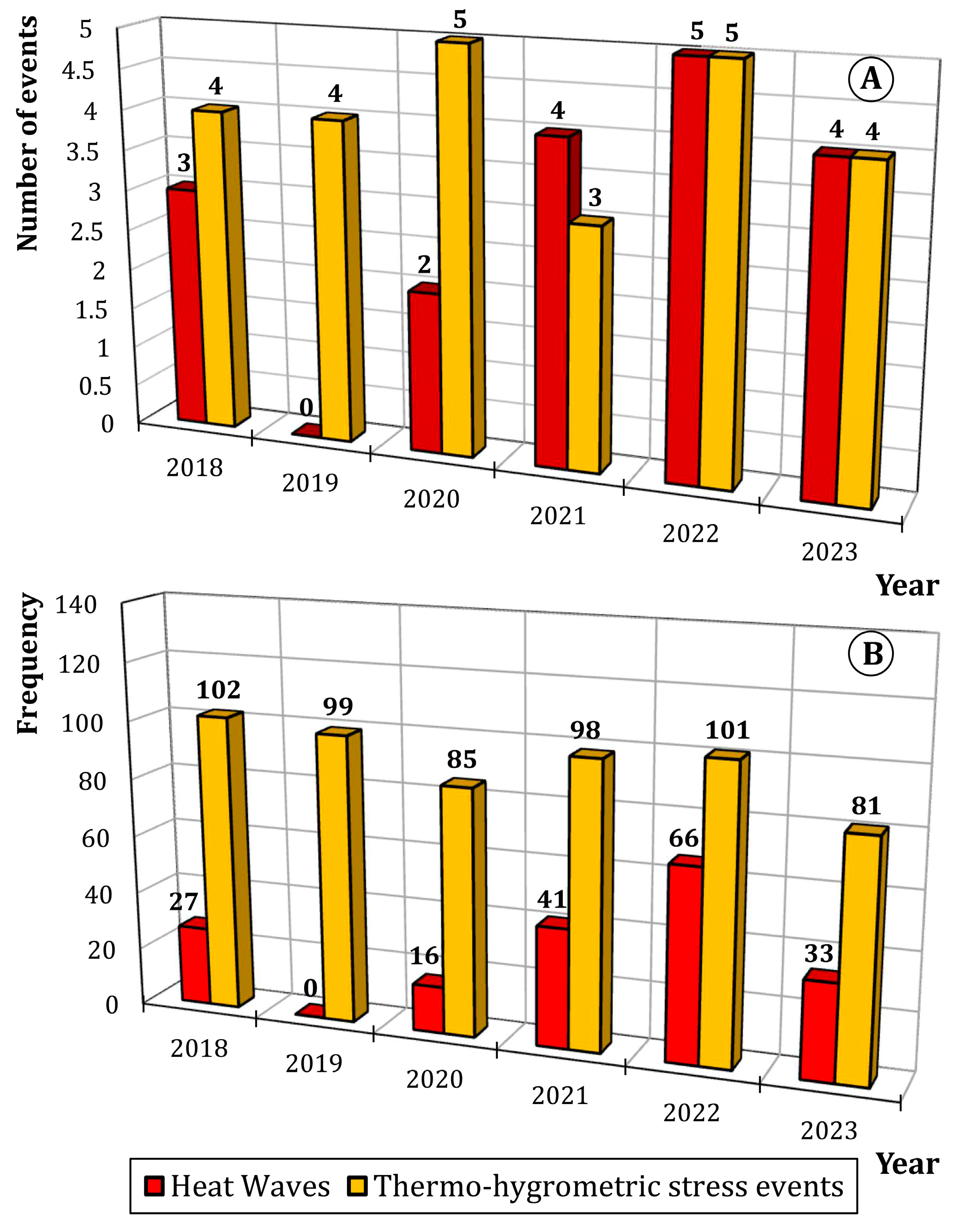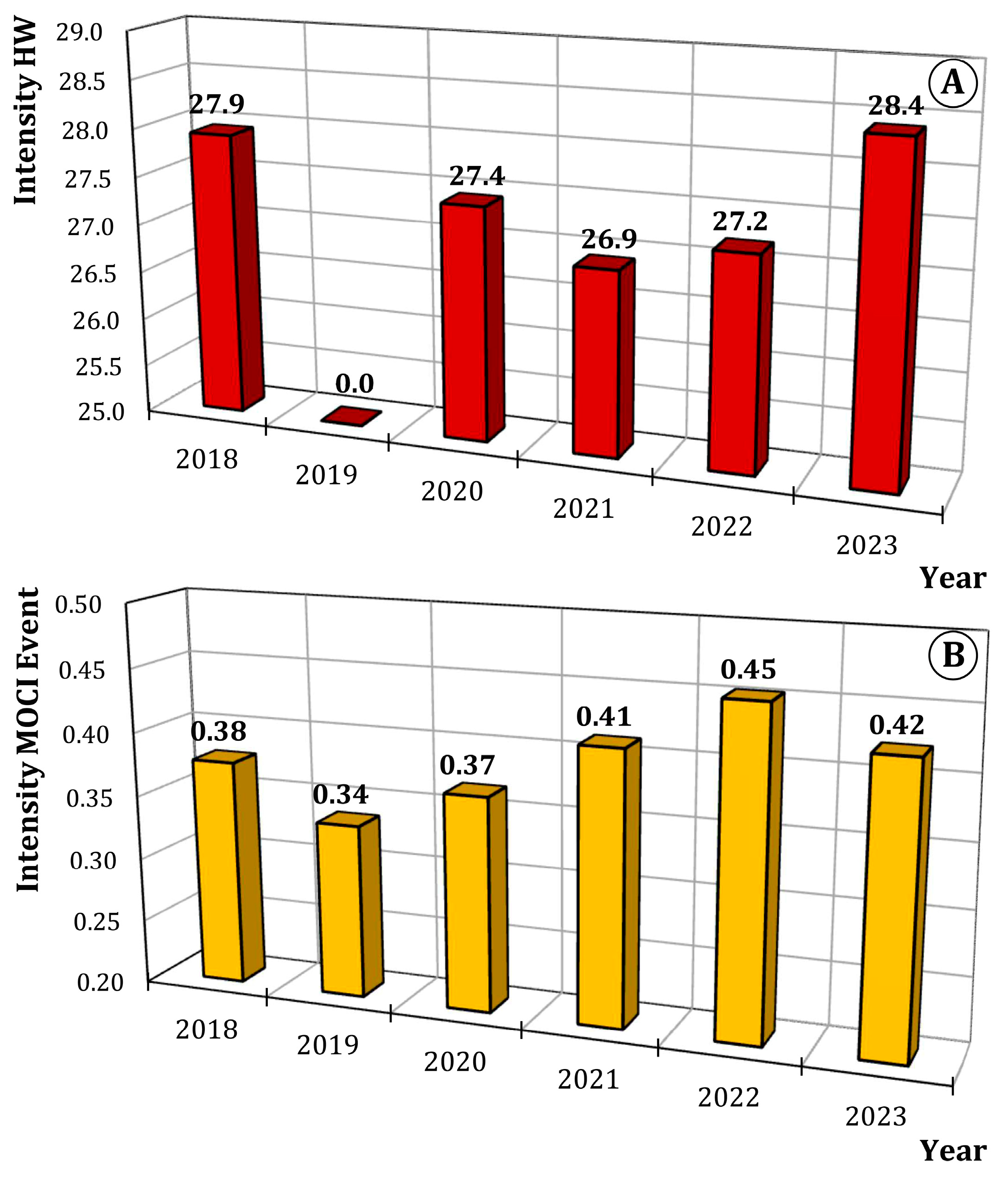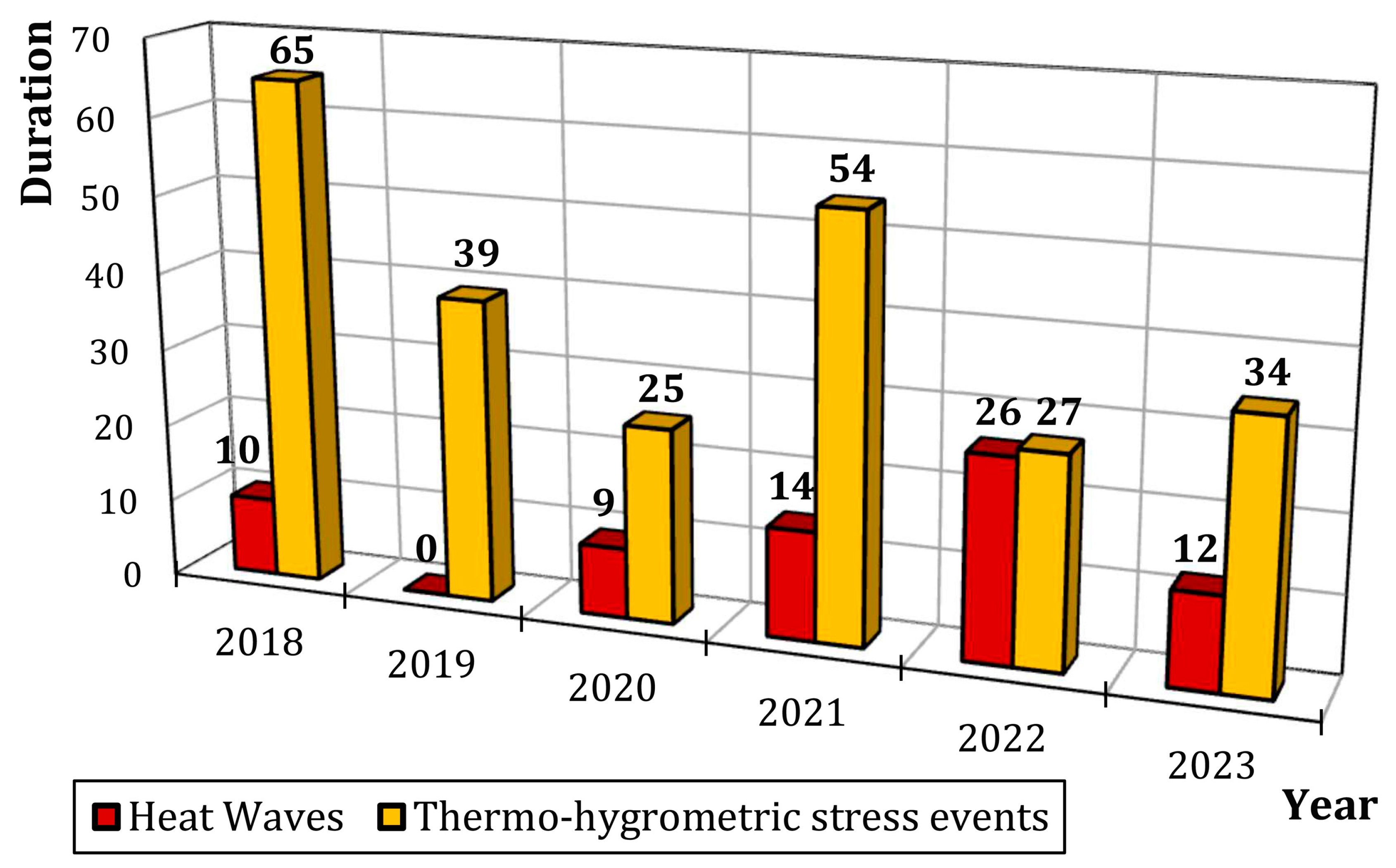Can Heat Waves Fully Capture Outdoor Human Thermal Stress? A Pilot Investigation in a Mediterranean City
Abstract
1. Introduction
2. Materials and Methods
2.1. Site Description
2.2. Study Period and Input Data
2.3. Extreme Temperature Indices and Heat Waves
- -
- Annual TXx: the maximum value of daily maximum temperatures across the year
- -
- Annual TXn: the minimum value of daily maximum temperatures across the year
- -
- Annual TNx: the maximum value of daily minimum temperatures across the year
- -
- Annual TNn: the minimum value of daily minimum temperatures across the year
2.4. Severe Outdoor Human Thermal Conditions and Events
2.5. Hit Rate and False Alarm Rate
3. Results
3.1. Extreme Temperature Indices
3.2. Comparison Between Heat Waves and Outdoor Human Thermal Stress Events
3.3. Overlapping of Heat Waves and Outdoor Human Thermal Stress Events
4. Discussion
5. Conclusions
Author Contributions
Funding
Institutional Review Board Statement
Informed Consent Statement
Data Availability Statement
Acknowledgments
Conflicts of Interest
Abbreviations
| HW | Heat wave |
| OHTS | Outdoor human thermal stress event |
| MOCI | Mediterranean Outdoor Comfort Index |
| HR | Hit rate |
| FR | False alarm rate |
References
- ASHRAE Standard 55-2004; Thermal Environmental Conditions for Human Occupancy. ANSI/ASHRAE Standard: Atlanta, GA, USA, 2004.
- ASHRAE Standard 55-2010; Thermal Environmental Conditions for Human Occupancy. ANSI/ASHRAE Standard: Atlanta, GA, USA, 2010.
- Nikolopoulou, M.; Lykoudis, S. Thermal Comfort in Outdoor Urban Spaces: Analysis across Different European Countries. Build. Environ. 2006, 41, 1455–1470. [Google Scholar] [CrossRef]
- Coccolo, S.; Kämpf, J.; Scartezzini, J.-L.; Pearlmutter, D. Outdoor Human Comfort and Thermal Stress: A Comprehensive Review on Models and Standards. Urban Clim. 2016, 18, 33–57. [Google Scholar] [CrossRef]
- Potchter, O.; Cohen, P.; Lin, T.-P.; Matzarakis, A. Outdoor Human Thermal Perception in Various Climates: A Comprehensive Review of Approaches, Methods and Quantification. Sci. Total Environ. 2018, 631–632, 390–406. [Google Scholar] [CrossRef] [PubMed]
- Golasi, I.; Salata, F.; De Lieto Vollaro, E.; Coppi, M.; De Lieto Vollaro, A. Thermal Perception in the Mediterranean Area: Comparing the Mediterranean Outdoor Comfort Index (MOCI) to Other Outdoor Thermal Comfort Indices. Energies 2016, 9, 550. [Google Scholar] [CrossRef]
- Jendritzky, G.; De Dear, R.; Havenith, G. UTCI—Why Another Thermal Index? Int. J. Biometeorol. 2012, 56, 421–428. [Google Scholar] [CrossRef]
- Perkins, S.E.; Alexander, L.V. On the Measurement of Heat Waves. J. Clim. 2013, 26, 4500–4517. [Google Scholar] [CrossRef]
- Horton, R.M.; Mankin, J.S.; Lesk, C.; Coffel, E.; Raymond, C. A Review of Recent Advances in Research on Extreme Heat Events. Curr. Clim. Change Rep. 2016, 2, 242–259. [Google Scholar] [CrossRef]
- Kim, D.-W.; Kwon, C.; Kim, J.; Lee, J.-S. Characteristics of Heat Waves from a Disaster Perspective. J. Prev. Med. Public Health 2020, 53, 26–28. [Google Scholar] [CrossRef]
- Yadav, N.; Rajendra, K.; Awasthi, A.; Singh, C.; Bhushan, B. Systematic Exploration of Heat Wave Impact on Mortality and Urban Heat Island: A Review from 2000 to 2022. Urban Clim. 2023, 51, 101622. [Google Scholar] [CrossRef]
- Lv, L.-S.; Yin, L.; Liu, Y.; Zhou, C.-L.; Hu, J.; An, N.; Xie, X.; Zhang, X.-E.; Zhang, M.; Liu, X.-Y. The Effect of Heatwave and Cold Spell on Cardiovascular Disease Mortality in Central China, 2018–2022. Int. J. Biometeorol. 2025, 69, 581–589. [Google Scholar] [CrossRef]
- Cheng, J.; Xu, Z.; Bambrick, H.; Su, H.; Tong, S.; Hu, W. Heatwave and Elderly Mortality: An Evaluation of Death Burden and Health Costs Considering Short-Term Mortality Displacement. Environ. Int. 2018, 115, 334–342. [Google Scholar] [CrossRef] [PubMed]
- Xi, D.; Liu, L.; Zhang, M.; Huang, C.; Burkart, K.G.; Ebi, K.; Zeng, Y.; Ji, J.S. Risk Factors Associated with Heatwave Mortality in Chinese Adults over 65 Years. Nat. Med. 2024, 30, 1489–1498. [Google Scholar] [CrossRef]
- Nguyen, C.V.; Nguyen, M.; Nguyen, T.T. The Impact of Cold Waves and Heat Waves on Mortality: Evidence from a Lower Middle-income Country. Health Econ. 2023, 32, 1220–1243. [Google Scholar] [CrossRef]
- Morakinyo, T.E.; Ren, C.; Shi, Y.; Lau, K.K.-L.; Tong, H.-W.; Choy, C.-W.; Ng, E. Estimates of the Impact of Extreme Heat Events on Cooling Energy Demand in Hong Kong. Renew. Energy 2019, 142, 73–84. [Google Scholar] [CrossRef]
- Zinzi, M.; Agnoli, S.; Burattini, C.; Mattoni, B. On the Thermal Response of Buildings under the Synergic Effect of Heat Waves and Urban Heat Island. Sol. Energy 2020, 211, 1270–1282. [Google Scholar] [CrossRef]
- Jiang, S.; Lee, X.; Wang, J.; Wang, K. Amplified Urban Heat Islands during Heat Wave Periods. JGR Atmos. 2019, 124, 7797–7812. [Google Scholar] [CrossRef]
- Chew, L.W.; Liu, X.; Li, X.-X.; Norford, L.K. Interaction between Heat Wave and Urban Heat Island: A Case Study in a Tropical Coastal City, Singapore. Atmos. Res. 2021, 247, 105134. [Google Scholar] [CrossRef]
- Wu, Y.; Zhao, K.; Huang, J.; Arend, M.; Gross, B.; Moshary, F. Observation of Heat Wave Effects on the Urban Air Quality and PBL in New York City Area. Atmos. Environ. 2019, 218, 117024. [Google Scholar] [CrossRef]
- Kalisa, E.; Fadlallah, S.; Amani, M.; Nahayo, L.; Habiyaremye, G. Temperature and Air Pollution Relationship during Heatwaves in Birmingham, UK. Sustain. Cities Soc. 2018, 43, 111–120. [Google Scholar] [CrossRef]
- Huang, X.; Yao, R.; Xu, T.; Zhang, S. The Impact of Heatwaves on Human Perceived Thermal Comfort and Thermal Resilience Potential in Urban Public Open Spaces. Build. Environ. 2023, 242, 110586. [Google Scholar] [CrossRef]
- Lam, C.K.C.; Gallant, A.J.E.; Tapper, N.J. Short-Term Changes in Thermal Perception Associated with Heatwave Conditions in Melbourne, Australia. Theor. Appl. Clim. 2019, 136, 651–660. [Google Scholar] [CrossRef]
- Yu, S.-Y.; Lin, T.-P.; Matzarakis, A. Heat Impact Assessment and Heat Prevention Suggestions for Thermal Comfort at Large-Area and Long-Duration Outdoor Sport Events in Taiwan. Atmosphere 2025, 16, 805. [Google Scholar] [CrossRef]
- Herdt, A.J.; Brown, R.D.; Scott-Fleming, I.; Cao, G.; MacDonald, M.; Henderson, D.; Vanos, J.K. Outdoor Thermal Comfort during Anomalous Heat at the 2015 Pan American Games in Toronto, Canada. Atmosphere 2018, 9, 321. [Google Scholar] [CrossRef]
- Tomczyk, A.M.; Bednorz, E. Thermal Stress during Heat Waves and Cold Spells in Poland. Weather. Clim. Extrem. 2023, 42, 100612. [Google Scholar] [CrossRef]
- Di Napoli, C.; Pappenberger, F.; Cloke, H.L. Verification of Heat Stress Thresholds for a Health-Based Heat-Wave Definition. J. Appl. Meteorol. Climatol. 2019, 58, 1177–1194. [Google Scholar] [CrossRef]
- Zendeli, D.; Colaninno, N.; Maiullari, D.; Van Esch, M.; Van Timmeren, A.; Marconi, G.; Bonora, R.; Morello, E. From Heatwaves to ‘Healthwaves’: A Spatial Study on the Impact of Urban Heat on Cardiovascular and Respiratory Emergency Calls in the City of Milan. Sustain. Cities Soc. 2025, 124, 106181. [Google Scholar] [CrossRef]
- He, B.-J.; Wang, J.; Liu, H.; Ulpiani, G. Localized Synergies between Heat Waves and Urban Heat Islands: Implications on Human Thermal Comfort and Urban Heat Management. Environ. Res. 2021, 193, 110584. [Google Scholar] [CrossRef] [PubMed]
- Molina, M.O.; Sánchez, E.; Gutiérrez, C. Future Heat Waves over the Mediterranean from an Euro-CORDEX Regional Climate Model Ensemble. Sci. Rep. 2020, 10, 8801. [Google Scholar] [CrossRef]
- Erlat, E.; Türkeş, M.; Aydin-Kandemir, F. Observed Changes and Trends in Heatwave Characteristics in Turkey since 1950. Theor. Appl. Climatol. 2021, 145, 137–157. [Google Scholar] [CrossRef]
- Wedler, M.; Pinto, J.G.; Hochman, A. More Frequent, Persistent, and Deadly Heat Waves in the 21st Century over the Eastern Mediterranean. Sci. Total Environ. 2023, 870, 161883. [Google Scholar] [CrossRef] [PubMed]
- Hochman, A.; Marra, F.; Messori, G.; Pinto, J.G.; Raveh-Rubin, S.; Yosef, Y.; Zittis, G. Extreme Weather and Societal Impacts in the Eastern Mediterranean. Earth Syst. Dynam. 2022, 13, 749–777. [Google Scholar] [CrossRef]
- Falasca, S.; Di Bernardino, A.; Salata, F. On the Identification and Characterization of Outdoor Thermo-Hygrometric Stress Events. Urban Clim. 2023, 52, 101728. [Google Scholar] [CrossRef]
- Petenko, I.; Mastrantonio, G.; Viola, A.; Argentini, S.; Coniglio, L.; Monti, P.; Leuzzi, G. Local Circulation Diurnal Patterns and Their Relationship with Large-Scale Flows in a Coastal Area of the Tyrrhenian Sea. Bound.-Layer Meteorol. 2011, 139, 353–366. [Google Scholar] [CrossRef]
- Di Bernardino, A.; Iannarelli, A.M.; Diémoz, H.; Casadio, S.; Cacciani, M.; Siani, A.M. Analysis of Two-Decade Meteorological and Air Quality Trends in Rome (Italy). Theor. Appl. Climatol. 2022, 149, 291–307. [Google Scholar] [CrossRef]
- Beck, H.E.; McVicar, T.R.; Vergopolan, N.; Berg, A.; Lutsko, N.J.; Dufour, A.; Zeng, Z.; Jiang, X.; Van Dijk, A.I.J.M.; Miralles, D.G. High-Resolution (1 Km) Köppen-Geiger Maps for 1901–2099 Based on Constrained CMIP6 Projections. Sci. Data 2023, 10, 724. [Google Scholar] [CrossRef]
- Fanger, P.O. Thermal Comfort: Analysis and Applications in Environmental Engineering; McGraw-Hill: New York, NY, USA, 1972; ISBN 9780070199156. [Google Scholar]
- Fanger, P.O. Assessment of Man’s Thermal Comfort in Practice. Occup. Environ. Med. 1973, 30, 313–324. [Google Scholar] [CrossRef]
- Guo, Y.; Gasparrini, A.; Armstrong, B.G.; Tawatsupa, B.; Tobias, A.; Lavigne, E.; Coelho, M.D.S.Z.S.; Pan, X.; Kim, H.; Hashizume, M.; et al. Temperature Variability and Mortality: A Multi-Country Study. Environ. Health Perspect. 2016, 124, 1554–1559. [Google Scholar] [CrossRef] [PubMed]
- Papadopoulos, G.; Keppas, S.C.; Parliari, D.; Kontos, S.; Papadogiannaki, S.; Melas, D. Future Projections of Heat Waves and Associated Mortality Risk in a Coastal Mediterranean City. Sustainability 2024, 16, 1072. [Google Scholar] [CrossRef]
- Nastos, P.; Saaroni, H. Living in Mediterranean Cities in the Context of Climate Change: A Review. Int. J. Climatol. 2024, 44, 3169–3190. [Google Scholar] [CrossRef]
- Settanta, G.; Fraschetti, P.; Lena, F.; Perconti, W.; Piervitali, E. Recent Tendencies of Extreme Heat Events in Italy. Theor. Appl. Clim. 2024, 155, 7335–7348. [Google Scholar] [CrossRef]
- Karl, T.R.; Nicholls, N.; Ghazi, A. (Eds.) CLIVAR/GCOS/WMO Workshop on Indices and Indicators for Climate Extremes Workshop Summary; Weather and Climate Extremes; Springer: Dordrecht, The Netherlands, 1999; pp. 3–7. [Google Scholar]
- Fischer, E.M.; Schär, C. Consistent Geographical Patterns of Changes in High-Impact European Heatwaves. Nat. Geosci. 2010, 3, 398–403. [Google Scholar] [CrossRef]
- Falasca, S.; Ciancio, V.; Salata, F.; Golasi, I.; Rosso, F.; Curci, G. High Albedo Materials to Counteract Heat Waves in Cities: An Assessment of Meteorology, Buildings Energy Needs and Pedestrian Thermal Comfort. Build. Environ. 2019, 163, 106242. [Google Scholar] [CrossRef]
- Perkins-Kirkpatrick, S.E.; Lewis, S.C. Increasing Trends in Regional Heatwaves. Nat. Commun. 2020, 11, 3357. [Google Scholar] [CrossRef]
- Oudin Åström, D.; Schifano, P.; Asta, F.; Lallo, A.; Michelozzi, P.; Rocklöv, J.; Forsberg, B. The Effect of Heat Waves on Mortality in Susceptible Groups: A Cohort Study of a Mediterranean and a Northern European City. Environ. Health 2015, 14, 30. [Google Scholar] [CrossRef]
- De’ Donato, F.; Leone, M.; Scortichini, M.; De Sario, M.; Katsouyanni, K.; Lanki, T.; Basagaña, X.; Ballester, F.; Åström, C.; Paldy, A.; et al. Changes in the Effect of Heat on Mortality in the Last 20 Years in Nine European Cities. Results from the PHASE Project. Int. J. Environ. Res. Public Health 2015, 12, 15567–15583. [Google Scholar] [CrossRef]
- Sánchez Jiménez, J.L.; Ruiz De Adana, M. Assessment of Outdoor Thermal Comfort in a Hot Summer Region of Europe. Atmosphere 2024, 15, 214. [Google Scholar] [CrossRef]
- Lai, D.; Lian, Z.; Liu, W.; Guo, C.; Liu, W.; Liu, K.; Chen, Q. A Comprehensive Review of Thermal Comfort Studies in Urban Open Spaces. Sci. Total Environ. 2020, 742, 140092. [Google Scholar] [CrossRef]
- Huang, B.; Dong, X.; Tian, Y.; Yin, M.; Qiu, Y.; He, B.-J. Experimental Investigation of the Thermal Usability of Outdoor Environments in Rideability, Walkability, Entertainmentability, Exercisability and Workability for Urban Heat Mitigation, Adaptation and Governance. Nat. Hazards 2024, 120, 2005–2034. [Google Scholar] [CrossRef]






| Site | Variable 1 | Time Span | Network | Purpose |
|---|---|---|---|---|
| Collegio Romano | Air Temperature | 2000–2020 | CREA | Baseline for the detection of HWs |
| Boncompagni | Air Temperature, wind speed, relative humidity, and solar irradiance | 2018–2023 | ARPA Lazio | Extreme temperature indices |
| Quantity | Description | Units |
|---|---|---|
| Heat waves (HWs) | A spell of at least six consecutive days with the daily maximum temperature exceeding the calendar day 90th percentile centered on a 5-day window for the reference period | - |
| Outdoor human thermal stress events (OHTS events) | A period of at least six consecutive days characterized by maximum daily values of the MOCI always being equal to or above 0.5. The maximum MOCI is computed considering the hourly MOCI values between 8:00 and 22:00 LT | - |
| Frequency | Sum of all days of HWs/OHTS events [46] | [Days] |
| Intensity | Average temperature and MOCI across all days of HWs and OHTS events, respectively | [°C] for HWs [-] for OHTS |
| Duration | Number of days of the longest HW/OHTS event | [Days] |
| Cumulative heat (during HWs) | Sum of the anomaly between each HW day and the calendar day 90th percentile across all HW days [46] | [°C] |
| Predicted | |||
|---|---|---|---|
| Event | Non-Event | ||
| Predictor | Event | a | b |
| Non-event | c | d | |
| Year | Predictor: Heat Waves | Predictor: Outdoor Human Thermal Stress Events | ||
|---|---|---|---|---|
| Hit Rate | False Alarm Rate | Hit Rate | False Alarm Rate | |
| 2018 | 26 | 0 | 100 | 60 |
| 2020 | 19 | 0 | 100 | 50 |
| 2021 | 28 | 25 | 66 | 63 |
| 2022 | 65 | 0 | 100 | 40 |
| 2023 | 33 | 8 | 82 | 45 |
Disclaimer/Publisher’s Note: The statements, opinions and data contained in all publications are solely those of the individual author(s) and contributor(s) and not of MDPI and/or the editor(s). MDPI and/or the editor(s) disclaim responsibility for any injury to people or property resulting from any ideas, methods, instructions or products referred to in the content. |
© 2025 by the authors. Licensee MDPI, Basel, Switzerland. This article is an open access article distributed under the terms and conditions of the Creative Commons Attribution (CC BY) license (https://creativecommons.org/licenses/by/4.0/).
Share and Cite
Falasca, S.; Salata, F.; Di Bernardino, A.; Iannarelli, A.M.; Siani, A.M. Can Heat Waves Fully Capture Outdoor Human Thermal Stress? A Pilot Investigation in a Mediterranean City. Atmosphere 2025, 16, 1145. https://doi.org/10.3390/atmos16101145
Falasca S, Salata F, Di Bernardino A, Iannarelli AM, Siani AM. Can Heat Waves Fully Capture Outdoor Human Thermal Stress? A Pilot Investigation in a Mediterranean City. Atmosphere. 2025; 16(10):1145. https://doi.org/10.3390/atmos16101145
Chicago/Turabian StyleFalasca, Serena, Ferdinando Salata, Annalisa Di Bernardino, Anna Maria Iannarelli, and Anna Maria Siani. 2025. "Can Heat Waves Fully Capture Outdoor Human Thermal Stress? A Pilot Investigation in a Mediterranean City" Atmosphere 16, no. 10: 1145. https://doi.org/10.3390/atmos16101145
APA StyleFalasca, S., Salata, F., Di Bernardino, A., Iannarelli, A. M., & Siani, A. M. (2025). Can Heat Waves Fully Capture Outdoor Human Thermal Stress? A Pilot Investigation in a Mediterranean City. Atmosphere, 16(10), 1145. https://doi.org/10.3390/atmos16101145









